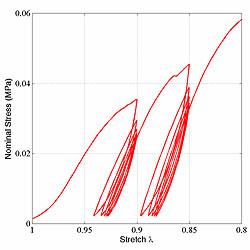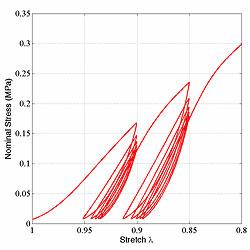Silk Biomaterials
Mechanical Properties of Hydrogel Biopolymers

Figure 1: Compression loading-unloading cycles of a biocompatible and biodegradable polymer hydrogels with 8% silk fibroin concentration.

Figure 2: Compression loading-unloading cycles of a biocompatible and biodegradable polymer hydrogels with 10% silk fibroin concentration.

Figure 3: Compression loading-unloading cycles of a biocompatible and biodegradable polymer hydrogels with 16% silk fibroin concentration.
Biocompatible and biodegradable polymer hydrogels are useful carriers to deliver bioactive molecules and cells for biomedical applications, such as in tissue engineering and controlled drug release.
Hydrogels used in these types of applications have mechanical and structural properties similar to some tissues and extracellular matrices (ECM) and can be implanted for tissue restoration or for local release of therapeutic factors.
Purified native silk fibroin forms b-sheet-rich crosslinked hydrogel structures from aqueous solution, with the details of the process and gel properties influenced by both environmental parameters and total fibroin concentration.
The objective of this project is to use recently obtained experimental data to develop a constitutive model to account for the nonlinear mechanical properties of these hydrogels at various concentrations, including finite deformation pseudo-elasticity and energy dissipation associated with hysteresis. The model is fitted to the available data and its predictions assessed.
Publications
- Kluge JA, Leisk G, Cardwell RS, Fernandes AP, House, M., Ward A, Dorfmann AL, Kaplan DL (2011) Bioreactor system for biomaterial design studies utilizing real-time mechanical loading control and noninvasive imaging. Ann Biomed Eng 39:1390-1402.
- Kluge JA, Thurber A, Leisk G, Kaplan DL, Dorfmann A (2010) A model for the stretch-mediated enzymatic degradation of silk fibers. J Mech Behav Biomed 3:538-547.
- Kluge JA, Rosiello NA, Leisk G, Kaplan DL, Dorfmann A (2010) The Consolidation Behavior of Silk Hydrogels. J Mech Behav Biomed 3:278-289.
- Soffer L, Wang X, Zhang X, Kluge J Dorfmann L, Kaplan D, Leisk G (2008) Silk-based electrospun tubular scaffolds for tissue-engineered vascular grafts. Journal of Biomaterials Science 19:653-664.
- Kim UJ, Park JY, Li CM, Jin HJ, Valluzzi R, Kaplan DL (2004) Structure and properties of silk hydrogels. Biomacromolecules 5:786-92.